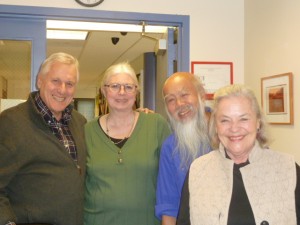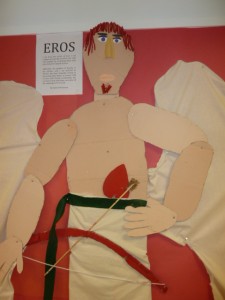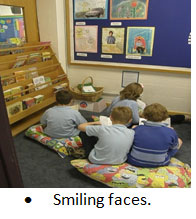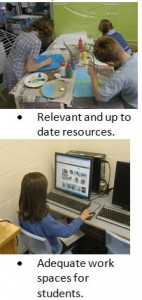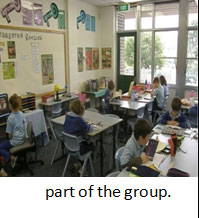AN OUTSTANDING PATHWAY SCHOOL: THE BANKSTREET SCHOOL FOR CHILDREN, PART OF THE BANK STREET COLLEGE OF EDUCATION
By Peter J. Foley, Ed.D. ( reporting from New York City, February 2012) |
| If you are fortunate enough to study at the Bank Street College Graduate School of Education or even to visit the Bankstreet School for Children, you don’t have to ask how the children are doing. You can access the students’ achievements and learning by simply looking all around you. Their work, their learning is everywhere: on the walls, the ceiling, the tables and the floors. The students’ work reflect their interests, their world.
Below is a picture of an early elementary class’s paper Mache representation of the Hudson River and its present day surroundings. The study of the Hudson River is a three month study of the river that starts with where the second grade students are developmentally, beginning with the here and now that surrounds them. The representation in the photo is what the student knows about the river through observation and research from a range of sources. Part of the second grade student exploration of the Hudson River included a visit to the 79th Street Boat Basin. Below is one student’s representation of that visit. Gradually, the students will go back in time to the Linape Native Americans who lived along the Hudson River before the explorers from Europe came to North America. Later in fourth grade students study the Egyptians along the Nile River, a place they have never been before. This is what we mean by Bank Street’s development interaction approach, as described by Stan Chu, senior faculty member in the Bank Street Graduate School of Education. This approach to learning enables children to integrate their world that has meaning and importance to them and eventually moving back in time and into far- away places. I noted that differentiated learning was going on all around me. So, each child was presented with learning activities that were within her or his reach, a reflection of Vygotsky’s Proximal Zone. I also saw that teachers integrated learning so that , for example, when in history the children studied explorers , in art they made puppets representing the explorers. The teacher, no doubt, continued this integration in English geography and even in science and math classes( e.g. mapping, navigation and surveying). An art teacher explained to me that they used art at the beginning of the year when students set about making rules of etiquette and classroom management. He explained that the teachers asked their students to recall a time when someone had helped them or been very kind to them and then to illustrate that time and event in a picture. This continually making the child the center of gravity in the school was impressive. Below, for example, are student renditions of what they feel about the snow . I was shown large outdoor space fenced off with many pieces of sanded and varnished pieces of wood and also what looked like blocks of wood, known as hollow blocks, which were originally designed by Caroline Pratt, founder of the City and Country School. Children, ages 5 to 7 play and learn here once a day for an hour and build all kinds of structures. I watched a couple of four year old boys building what looked like a miniature house. They had divided up the labor, one boy carrying lumber back to the project for the floors another working on the side of the miniature house. Another characteristic of the school is teaching collaborative learning. Students here are learning the value and effectiveness of cooperative efforts that lead to surprising achievements that a single individual could not hope to accomplish, while recreating parts of their physical world. I came away from the visit to the school euphoric. When I asked myself why , I realized that it was being in the company of so many teachers that were interested and happy in their work was infectious. They loved what they were doing and could see daily that they were enabling children to understand deeply the world around them and guiding these children on a journey that included a joy for learning. I met a dozen or so teachers and all were smiling, happy, enthusiastic and bursting with energy. I noted that at the end of the school day the smiles and enthusiasm were still there. Yes, I can hear a traditional educator asking as they read this, “but do these students at Banksstreet Children’s School really master the necessary skills to go on to college?” The proof is that tracking of their students both in high school and college shows the students perform well beyond the norm. But I wanted to see for myself. I read the essays posted on the bulletin board about Steinbeck’s Of Mice and Men. All the essays were masterfully written. Most were of a quality of writing far, far beyond the seventh grade level. Nevertheless, the highlight of my observations was the art work of the three year olds. These are stabiles created out of pipe cleaners and assorted materials. One piece in particular already showed symmetric and color combination genius. Miro , the celebrated Majorcan artist, I know ,would have been pleased with this work of art. This school is an inspiration and those who are touched by this school will have received the certain knowledge that real education is all about nurturing and meeting children in the world that is meaningful and makes sense to children. Also realized is that effective teaching is more like coaching children to expand their worlds and become a creator of their world in a meaningful way that will bring personal contentment and confidence. Children education in this way are enabled to contribute also to the well being of those around them. |
Welcome to Student-Centered Learning
Thailand
LONG LIVE THE KING!
Our Mission:
To provide a center of discussion , information and planning for 21st Century education reform in Thailand that will lead to a unity of purpose and action among Thai and international educators to realize the goals set forth in the National Education Act of B.E. 2542 (1999).
At the heart of this National Education Act B.E. 2542 (1999) is a move toward student -centered learning and a student- centered classroom. Specifically, Section 24 of the Education Act outlines what must be done to improve education performance : 1. arranging learning in line with the students’ interests , aptitudes and individual differences ;2. training students in thinking abilities, especially critical thinking; 3.organizing learning activities that draw from authentic experiences; and 4. promoting situations where learners and teachers learn together.
In addition to addressing these key issues of education reform in Thailand , indeed in international education, we also focus our attention and resources on the goal of promoting Thai teachers to reach their potential as skilled teachers using teaching methods that engage their students with the result that students love to learn through self discovery.
โรงเรียนนำร่องที่น่าเรียนรู้ : โรงเรียนแบงค์สตรีทสำหรับเด็กในวิทยาลัยการศึกษาแบงค์สตรีท
โดย ดอกเตอร์ปีเตอร์ เจ. โฟลีย์ (รายงานจากนิวยอร์คซิตี้ กุมภาพันธ์ 2555)
ถ้าคุณโชคดีพอที่จะได้เรียนที่บัณฑิตวิทยาลัย วิทยาลัยการศึกษา Bank Street หรือแม้แต่เข้าไปเยี่ยมชมที่โรงเรียน Bank Street คุณไม่จำเป็นต้องถามเลยว่าเด็กๆทำอะไรกันบ้าง ท่านสามารถเข้าถึงความสำเร็จและการเรียนรู้ของเด็กนักเรียนได้เพียงการมองไปรอบตัว ผลงานของพกเขามีอยู่ทุกที่ ทั้งบนผนัง, บนเพดาน, บนโต๊ะและบนพื้น งานของเด็กนักเรียนสะท้อนออกถึงความสนใจของพวกเขา โลก ของเขา
ข้างล่างคือภาพผลงาน Paper Mache แสดงทิวทัศน์แม่น้ำฮัดสันและเมืองรอบแม่น้ำในตอนกลางวันของนักเรียนชั้นประถม การศึกษาสภาพโดยรอบแม่น้ำใช้เวลาสามเดือน งานที่เราเห็นในภาพคือตัวแทนของสิ่งที่นักเรียนได้เรียนรู้ผ่านการสังเกตและศึกษาจากแหล่งข้อมูลต่างๆ
ส่วนหนึ่งของงานสำรวจแม่น้ำฮัดสันของนักเรียนประถมสองรวมไปถึงการไปดูที่ถนน Boat Basin สายที่ 79 ภาพล่างคือผลงานหนึ่งของนักเรียนที่แสดงให้เห็นถึงการไปครั้งนั้น
อย่างช้าๆ นักเรียนจะย้อนเวลากลับไปหาชนอเมริกันพื้นเมืองที่อาศัยอยู่ตามแนวแม่น้ำฮัดสันก่อนที่คณะนักสำรวจจากยุโรปจะเข้ามาที่อเมริกาเหนือ จากนั้นในชั้นปีที่สี่ นักเรียนเรียนเกี่ยวกับชาวอียิปต์และแม่น้ำไนล์ สถานที่ที่พวกเขาไม่เคยรู้จักมาก่อน นี่คือสิ่งที่เราเรียกว่าวิธีการพัฒนาแบบปฏิสัมพันธ์ของBank Street อย่างที่ Stan Chu อาจารย์อาวุโสแห่งศึกษาบัณฑิตวิทยาลัยการศึกษาBank Street ได้ให้คำจำกัดความไว้
วิธีการเรียนรู้นี้ช่วยให้เด็กสามารถบูรณาการสิ่งต่างๆที่มีความหมายและความสำคัญของตัวเองเข้ามาและย้อนกลับไปในช่วงเวลาก่อนหน้ารวมถึงสถานที่ห่างไป ผู้เขียนสังเกตเห็นว่าการเรียนรู้หลากหลายวิธีกำลังเกิดขึ้นอยู่รอบตัว ดังนั้น เด็กแต่ละคนจะได้รับวิธีการเรียนรู้ในรูปแบบต่างๆกันตามที่พวกเขาจะเข้าถึง ตามทฤษฎีของรอยต่อพัฒนาการของไวก็อตสกี้ ผู้เขียนสังเกตเห็นถึงการเรียนรู้แบบบูรณาการของอาจารย์เช่นเดียวกัน ยกตัวอย่างเช่น เมื่อเด็กเรียนเรื่องการสำรวจในวิชาประวัติศาสตร์ ในวิชาศิลปะพวกเขาก็จะแสดงละครหุ่นเกี่ยวกับการสำรวจ เช่นกันกับการบูรณาการความรู้นี้เข้าไปในวิชาภูมิศาสตร์อังกฤษหรือแม้แต่วิทยาศาสตร์และคณิตศาสตร์ (เช่นการทำแผนที่ความคิด, เส้นทางการเดินทางและการสำรวจ) ครูผู้สอนศิลปะอธิบายแก่ผู้เขียนว่าพวกเขาเริ่มใช้ศิลปะในตอนแรกๆที่นักเรียนพูดถึงการตั้งข้อกำหนดทางมารยาทและการจัดการห้องเรียน ครูศิลปะขอให้นักเรียนนึกถึงช่วงเวลาที่มีเคยได้รับความช่วยเหลือหรือมีคนทำดีด้วย และให้นักเรียนวาดภาพเหตุการณ์ในตอนนั้นออกมาในรูปภาพ
การสร้างให้นักเรียนเป็นศูนย์กลางของกิจกรรมต่างๆในโรงเรียนอย่างต่อเนื่องเป็นสิ่งที่น่าประทับใจมาก เช่นที่แสดงข้างล่างคือการสะท้อนความรู้สึกที่พวกเขามีต่อหิมะ
ผู้เขียนถูกพาไปชมสนามกลางแจ้งในรั้วโรงเรียนที่เต็มไปด้วยกองทรายและชิ้นไม้ขัดเงาและสิ่งที่เหมือนกับบล็อคไม้ที่เรียกกันว่าบล็อคกลวงที่ถูกคิดขึ้นโดยแคโรไลน์ พราทต์ ผู้ก่อตั้งโรงเรียนประจำชุมชน เด็กอายุระหว่าง 5 – 7 ปีจะลงมาเล่นและเรียนที่นี่วันละชั่วโมงเพื่อสร้างทุกอย่างที่พวกเขานึกออก ผู้เขียนเฝ้าดูเด็กสี่ขวบคู่หนึ่งช่วยกันสร้างสิ่งที่ดูเหมือนบ้านขนาดเล็ก พวกเขาแบ่งงานกันทำ คนหนึ่งเดินขนไม้กลับไปให้เพื่อนที่กำลังสร้างบ้านอีกด้านหนึ่งอยู่ บทบาทอีกอย่างหนึ่งของโรงเรียนคือการสอนให้เด็กเรียนรู้การทำงานร่วมกัน เด็กนักเรียนที่นี่ได้เรียนรู้คุณค่าและประสิทธิภาพของความร่วมมือที่นำไปสู่ความสำเร็จอันน่าทึ่งที่คนหนึ่งคนไม่อาจหวังจะทำสำเร็จผ่านการสรรสร้างโลกเล็กๆของพวกเขา
ผมกลับจากการชมโรงเรียนอย่างร่าเริง เมื่อตามตัวเองว่าทำไม ผู้เขียนตระหนักว่ามันคือผลของการเข้าไปอยู่รวมกับครูอาจารย์มากมายที่มีความกระตือรือร้นและมีความสุขในงานของตัวเอง พวกเขารักในสิ่งที่ทำและรักการได้เห็นว่าพวกเขาสามารถทำให้เด็กเข้าในอย่างลึกซึ้งในโลกรอบตัวที่พวกเขาอยู่และชี้ทางเด็กเหล่านี้ไปในเส้นทางที่การเรียนรู้เป็นเรื่องสนุกในทุกๆวัน ผู้เขียนได้พบอาจารย์นับสิบที่ต่างยิ้ม หัวเราะ กระตือรือร้นและเต็มเปี่ยมไปด้วยพลัง ผู้เขียนสัมผัสได้ถึงสิ่งเหล่านั้นกระทั่งหมดวัน
ผู้เขียนเข้าใจถึงสิ่งที่เหล่านักวิชาการศึกษาแบบเดิมจะถามเมื่อพวกเขาได้อ่านบทความนี้ “แต่แล้วเด็กที่โรงเรียนนี้มีความสามารถมากพอในสาขาวิชาที่จำเป็นในการเข้าเรียนต่อในระดับอุดมศึกษาหรือเปล่า?” ข้อพิสูจน์จากการติดตามเด็กนักเรียนทั้งในระดับมัธยมและวิทยาลัยพบว่าเด็กเหล่านี้ทำได้ดีเกินกว่ามาตรฐาน
แต่ผู้เขียนอยากจะเห็นด้วยตาของตัวเอง ผู้เขียนได้อ่านเรียงความที่ติดบนป้ายประกาศ เกี่ยวกับนวนิยายเรื่องเพื่อนยาก ของจอห์น สไตน์เบ็ค
ทุกชิ้นเขียนได้ดีมาก เรียงความส่วนใหญ่เขียนได้ดีเกินมาตรฐานงานเขียนของนักเรียนเกรด 7 (ม. 1)
แต่ไฮไลท์ของการสังเกตของผู้เขียน อยู่ที่งานศิลปะของเด็กน้อยวัยสามขวบ
เหล่านี้คืองานประดิษฐ์สร้างจากที่ล้างท่อและวัสดุอื่นๆหลายชนิด ชิ้นหนึ่งที่เราเห็นได้ชัดเจนแสดงให้เห็นถึงอัจฉริยภาพในด้านความสมมาตรและการผสมผสานการใช้สีที่ผู้เขียนรู้ดีว่าแม้แต่ศิลปินชื่อก้องอย่างมิโรยังต้องประทับใจ
โรงเรียนแห่งนี้คือแรงบันดาลใจ และผู้ที่เข้ามาสัมผัสที่นี่จะได้รับความเข้าใจว่า การศึกษาที่แท้จริงนั้นคือการฟูมฟักและพบปะกับเด็กในสภาพที่เหมาะสมเพื่อช่วยเหลือให้โลกของพวกเขากว้างขึ้นและกลายเป็นผู้สรรสร้างโลกในทางที่เหมาะสมที่จะนำมาซึ่งความพึงพอใจและความมั่นใจของเด็กและขยายออกไปยังสังคมรอบตัวเด็กเอง
